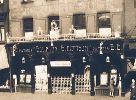The First Cinemas by James McKissack [Part 1]
In the 1911-12 period, McKissack designed his first cinema buildings,
the
Eglinton Electreum and
La Scala in Sauchiehall Street, Glasgow.
Cinema was still in its infancy, for it was less than 20 years since
Louis and Auguste Lumiere had shown a paying audience their
Cinematographe, which projected moving film onto a large screen; but
was already commanding huge public attention. In designing these
buildings he was taking the first steps towards a career in cinema
architecture, which was to develop fully after World War One.
McKissack had a great interest in photography, which probably explains
his interest in the cinema as a genre. This interest was probably
encouraged by his father, whose obituary in 1915, described him as a
well-known artist and photographer, in addition to his architectural
endeavours.
In 1911, James McKissack was accepted as a member of the Royal
Incorporation of British Architects. At that time, he was also
convenor of the photographic section of the Fine Art display at the
Scottish Exhibition of National History, Art and Industry at
Kelvingrove in Glasgow. In this role, he was assisted by Archibald
Cochrane and Frank P. Moffat, who operated the
Salon Cinema in
Glasgow’s Sauchiehall Street.
It is said that he occasionally exhibited his own photographs on visits
to mainland Europe and New York and as a member of the Edinburgh
Photographic Society (EPS), McKissack gave a lecture on
‘
Rothenburg and other Bavarian Towns’ in 1912, where his
architectural knowledge must have added a further dimension of interest
for the audience. Later, in 1916, it is recorded that he lectured
to them on ‘
Exhibition Pictures and how they were shown’.
This interest in photography must have been sustained throughout his
life, as in 1935, five years before his death, he was the Open
Exhibition Judge for the E.P.S.
At this time many buildings were adapted for use as cinemas, rather
than entirely new ones being built. This was not surprising given that,
at that time, the cinema remained something of a fairground novelty;
films spools were relatively short and silent (except for musical
accompaniment), and so the cinema venue might have been expected to
have had a lifespan no longer than a leased shop unit. Larger venues
could be fashioned from churches, factories, music halls and even
roller skating rinks; once that Edwardian pastime fell out of favour.
Showmanship was all important, however, and one of the
architect’s most important jobs was to design an entrance
façade, which promised romance, mystery and escapism from the
hard life many of the cinema’s patrons lived and worked in.
McKissack’s first cinema design was indeed a conversion of a shop
unit, located beneath tenements in Glasgow’s populous Laurieston
district. Its frontage certainly was eye-catching, it being in a
debased version of, the then fashionable, Art Nouveau style. Glasgow,
being a forward-looking industrial city, has always adapted to new
design trends. Although Art Nouveau is nowadays most associated with
such distinguished architects as Mackintosh and Burnet and their
celebrated works, as a style, it was used equally to adorn such
ephemeral premises as shop facades and public houses, many of which
have since been lost.
 |
The frontage of the Eglinton Electreum appears to have been vividly
coloured with an ornate timber-framed arcade to give some shelter to
those waiting outside. The name sign above used a typically Art Nouveau
font.
Two circular windows on either side of the main entrance appear
to be similar to those on Mackintosh’s country houses. Could it
be that McKissack was inspired by his work? Certainly, he was
acquainted with Miss Catherine Cranston, the Glasgow tearoom owner and
hotelier, for whom Mackintosh designed several premises.
|
|
The Eglinton Electreum’s interior consisted of a small entrance
hallway under the front third of the tenement block with a staircase
descending to the rear. The auditorium filled the remainder of the
space and extended into the back green. This steel framed structure was
two storeys high, but with only a single level of seats on a gently
raked floor. The seating consisted of wooden forms in the front section
with leather-upholstered tip-ups behind. The Eglinton Electreum was one of a
number of cinemas in Edwardian Glasgow built in this manner and
occupying the back courts of tenements. |
 |
Cinemas in these locations not
only robbed the occupants of the surrounding tenements of their drying
and playing areas but also blocked out daylight and prevented fresh air
from entering into their homes. Nevertheless, permission was usually
granted for their construction by local authorities as cinemas offered
cheap local entertainment for poorer citizens and provided a warm
sheltered place away from the cramped conditions of many homes. They
kept some out of pubs and others out of trouble. Perhaps these
considerations were felt to outweigh any possible nuisance factors for
their neighbours.